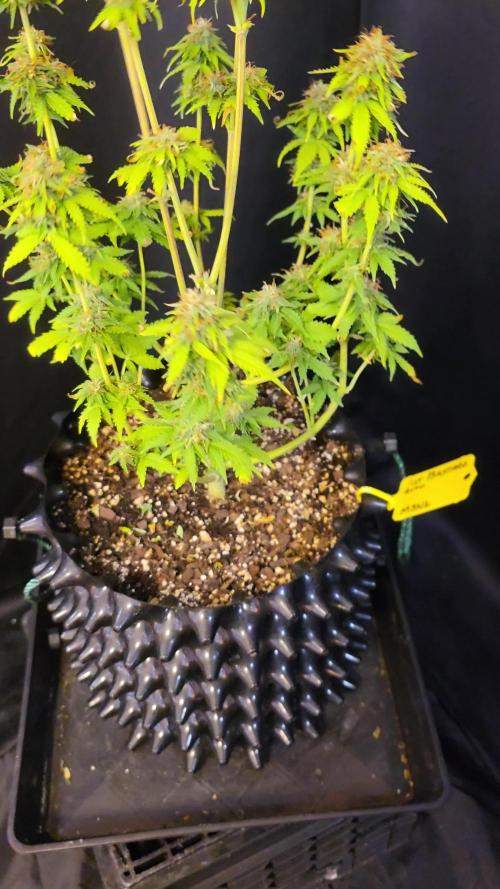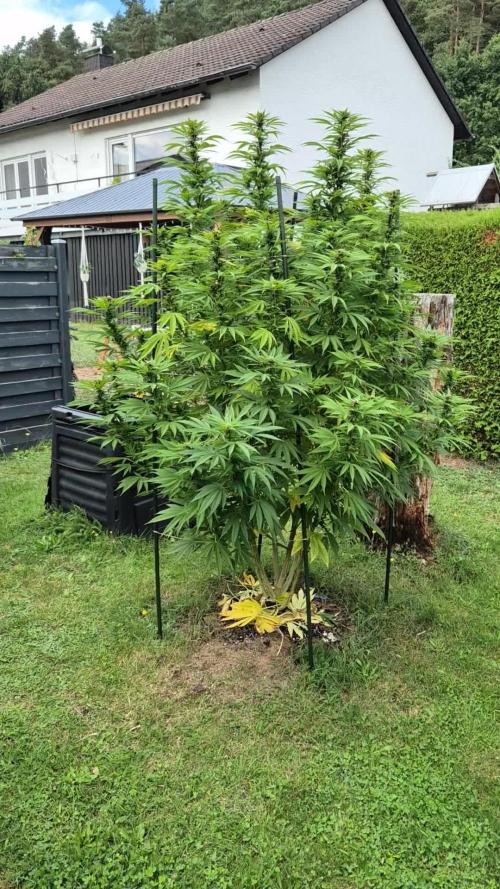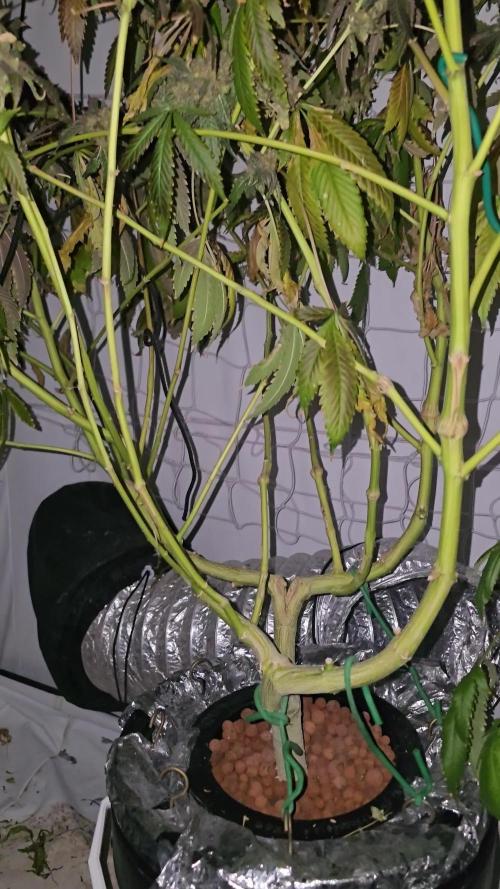The Grow Awards 2026 🏆 





























Likes
23
Share


@peterfly98
Follow
Day71: Tropicana cookies will be cut tomorrow or as soon as the soil dries a bit more.
Wedding cheesecake is getting denser. This week is the last feeding week for her, then she is going to get 10/14 days with water only.
Gorilla cookies is super bushy, I’m not going to be a fan when I’ll trim her but she is developing well and putting on some weight.
Day72: Tropicana cookies is drying! Now I got 2 plants in the tent.
I can’t wait to see wedding cheesecake colors at the end of the flush.
Gorilla cookies is going to get her last feeding as well and then she is going to get only water.
Day 75: pushing towards the end!
Processing
Likes
54
Share


@Mimi420
Follow
Hi growers!
The kushes are buding nice!Bubba kush started to coloring a litle.Dutch kush have such a nice smell.Loove the smell that is coming from the tent!
Stay green!🌱
Likes
16
Share


@Magic_frequency
Follow
Sorry guys as i have not weigh my buds much because ive been smoking them little by little 😂😂👌 so on my first harvest i had 12Gs. And on this one i think about 15-20gs well i need to weigh them when they are dry. Posting now cause i might be busy. Hopefully next grow i will have more time organizing my journals ❤️
Likes
46
Share


@Canna96
Follow
I am super happy with this strain, the pictures and videos truly don't do her justice. She absolutely reaks of blueberries, and the buds sparkle like diamonds. I am super excited to squish some blueberries here in a few weeks! I will update with a dry weight and a smoke report in a few weeks, thanks for stopping by, be safe, and Blaze On!!!
Likes
301
Share


@Roberts
Follow
9.6 ounces of green crack auto from seedsman. A mostly sativa 20 percent thc. I grew it into a monster. Thanks again seedsman. Great flowers as always. This has been the biggest plant I have grown yield wise. Plus a autoflower to top it off.
Thank you grow diaries community for the 👇likes👇, follows, comments, and subscriptions on my YouTube channel👇.
❄️🌱🍻 https://www.seedsman.com/?a_aid=Mrsour420.
This is my affiliate link to seedsman.
Thank you Happy Growing 🌱🌱🌱
https://youtube.com/channel/UCAhN7yRzWLpcaRHhMIQ7X4g.
Processing
Likes
14
Share


@AlienScrOG
Follow
Grow well... C° very hot ....... After 4 day .. ppm to 920ppm ...add pk no N
Likes
8
Share


@Sourpatchkiid
Follow
Both plants are thriving. The mimosa still growing fast despite the fact it was burned by the light. The bourbon berry is trying to keep up with the mimosa plant.
Processing
Likes
17
Share


@greennug
Follow
plants looking great dinafem standing out from the crowd.my stardawg cuttings are thriving and a few of the fastbuds strains look beautiful.should be kicking into flower late next week. daily updates until harvest!
Likes
72
Share


@Roberts
Follow
Auto Maxi Gom is making progress. She is shifting more into a stretching, and stronger pre flowering phase. She should start developing more colas in the next weeks to come. She is just doing her thing, and making progress. Thank you Xpert Nutrients, Medic Grow, and Seeds Mafia. 🤜🏻🤛🏻🌱🌱🌱
Thank you grow diaries community for the 👇likes👇, follows, comments, and subscriptions on my YouTube channel👇. ❄️🌱🍻
Happy Growing 🌱🌱🌱
https://youtube.com/channel/UCAhN7yRzWLpcaRHhMIQ7X4g
Likes
53
Share


@Roberts
Follow
Merlin Mintz Autoflower is growing great. She got a solution change yesterday, and ph correction today. Everything is looking good m, and she looks like she might start bulking. Thank you Aeque Genetics, Spider Farmer and, Athena. 🤜🏻🤛🏻🌱🌱🌱
Thank you grow diaries community for the 👇likes👇, follows, comments, and subscriptions on my YouTube channel👇. ❄️🌱🍻
Happy Growing 🌱🌱🌱
https://youtube.com/channel/UCAhN7yRzWLpcaRHhMIQ7X4g
Likes
6
Share


@Krissci
Follow
Day 1 ....add additional soil, water and 1st topping
Day 3 - checked for 2nd topping
Day 5- watering....strong stems already
Likes
44
Share


@Natrona
Follow
Fat Bastard Auto by MSNL
👉Sponsored Grow👈
W7F6 8/4 10-16
Watered at the end of last week and have not watered yet this week. I have been foliar feeding at least once a day with the blend.
Calmag 15ml
Plant Juice 60ml
GH bloom 5ml
Green Sensation 4ml
Feed was ph 6.37, ppm 784 at 65f.
I ph’d the water down to 6.25 with brought the runoff down to a range of 6.7-7.42 on the plants in the tent. I think it should be lower, but in the meantime, I hope this helps my tent family recover from lockout.
I defoliated to remove yellow leaves and an undesirable new discovery appeared 😱. I wasn't sure so I asked. Well within minutes, i had my answer. I saw pollen sacs 😡. Damn it. Fat Bastard is a bastard. This is my first plant to hermie on me. My responder gave instructions so I cut off the sacs and threw in the toilet. Further examination shows what I think is she already pollinate self and has seeds. I will grow her out for next month. This grow that was supposed to be easy, water only, with a clean finish, has been anything but.
Thank you all for your continued support and encouragement. Your likes and comments motivate me to keep sharing my journey. Let’s continue to learn to grow together!
Stay green, growers love 💚🌿
💫Natrona💫
Likes
80
Share


@Smoking_Joe_Frazier
Follow
Flowering Week 26: Storm Battles & Resilience
Update: 10.09.2025 | Day 187
Hey Growmies,
Week 26 decided to throw some serious weather at us – rain almost every day mixed with strong winds. It was enough to blow my African lady right off her socks! Durban Poison took a full tumble under the weight of those wet, dense buds. Lesson learned: never underestimate a sativa in a storm.
I reinforced the whole support setup – added more stakes and wired everything firmly to the fence in the back. Blueberry, on the other hand, stood strong like the queen she is – not even a lean.
Strain Check
· Durban Poison:
Took that fall like an absolute champion. Didn’t skip a beat – just kept bulking up like nothing happened. The smell is now coming in strong, and the colors are getting wilder every day. Respect.
· Blueberry:
Her buds are swelling nicely and the colors keep intensifying. She handled the monsoon rains and wind like it was a gentle breeze. Starting to give off a faint smell – still subtle, but it’s there.
Next Steps
· Continue weekly mineral feeding – they’re responding really well
· Stay on storm watch – check support structures regularly
· Keep an eye out for pests and mold (still all-clear, thankfully)
That's it for this week Growmies!
Catch y’all next week.
– Smoking_Joe_Frazier
Likes
15
Share


@Chubbs
Follow
420Fastbuds-FBA2503
I'm excited as it's tester time. Germination week is complete. I planted 3 seeds and had all 3 sprout within 48hrs of being in the soil. I do soak them for 48hrs in a glass of water before planting. I can't wait to see what the weeks to come will have in store. Happy Growing
Likes
48
Share


@AsNoriu
Follow
Day 36. One more heavy training session. Girls drink every day a liter at least, have to water them every 2-3 days and its good !! They got second wave of food , lost almost all oldest fan leaves and i think ill drop my plank to 80 g and will flower them next week.
Still never cracked is it better to clear bottoms before flip or with first wave of defoliation during flower. This time i'll lolipop them in flower.
In middle of last week found some mold on one leave - no waiting and hesitation - Biobizz LeafCoat applied ! Now can't find even smallest issue in them , pure perfectness !!!
Still think 10 girls is too much for my setup to bush them out, but i just can't throw away any plant ;))))
Damn - lesson for life !! Leave branches alone after watering !!! Itchy fingers and smallest plant have only 7 proper branches left, thought to move one a bit ... ;)))
Girls respond to training and food amazingly - late eves video is a proof !
Day 41. They just fly, thickness of branches is just amazing, leaves regrow faster than i pull them ;))) Today all girls will get bottoms cleaned and heavily defoliated, all tops will be HST'ed and i have power cut next tuesday, so monday - lights out for 24 hours of darkness, wednesday - flower starts !
Had to reposition them and bring in one more drain tray. Attack scheme still 2-3-3-2 ;)))
All Blue Dreams hated it, loads of supercroping, one stem split, but it looks like all is finalised for flowering !
Girls got Great White Mycorrhizae tea. Next pure water, later Molasses and only then updated feed, Root Juice out, Bloom and Heaven 2x , all plans and changes ...
Happy Growing !


























